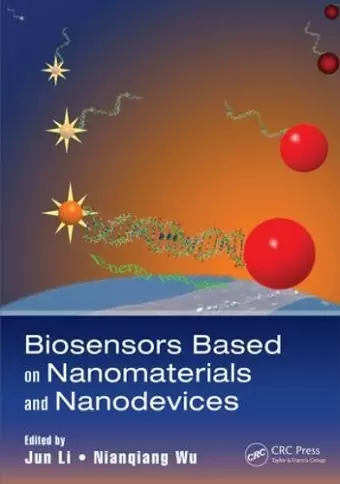Biosensors Based on Nanomaterials and Nanodevices
Jun Li editor Nianqiang Wu editor
Format:Hardback
Publisher:Taylor & Francis Inc
Published:20th Dec '13
Currently unavailable, and unfortunately no date known when it will be back
This hardback is available in another edition too:
- Paperback£81.99(9781138073258)

Biosensors Based on Nanomaterials and Nanodevices links interdisciplinary research from leading experts to provide graduate students, academics, researchers, and industry professionals alike with a comprehensive source for key advancements and future trends in nanostructured biosensor development. It describes the concepts, principles, materials, device fabrications, functions, system integrations, and applications of various types of biosensors based on signal transduction mechanisms, including fluorescence, photonic crystal, surface-enhanced Raman scattering, electrochemistry, electro-luminescence, field-effect transistor, and magnetic effect. The book:
- Explains how to utilize the unique properties of nanomaterials to construct nanostructured biosensors to achieve enhanced performance
- Features examples of biosensors based on both typical and emerging nanomaterials, such as gold nanoparticles, quantum dots, graphene, graphene oxides, magnetic nanoparticles, carbon nanotubes, inorganic nanowires/nanorods, plasmonic nanostructures, and photonic crystals
- Demonstrates the broad applications of nanostructured biosensors in environmental monitoring, food safety, industrial quality assurance, and in vitro and in vivo health diagnosis
- Inspires new ideas for tackling multiscale and multidisciplinary issues in developing high-performance biosensors for complex practical biomedical problems
Focusing on the connection between nanomaterials research and biosensor development, Biosensors Based on Nanomaterials and Nanodevices illustrates the exciting possibilities and critical challenges of biosensors based on nanomaterials and nanodevices for future health monitoring, disease diagnosis, therapeutic treatments, and beyond.
"Biosensors Based on Nanomaterials and Nanodevices explains the essential technologies in nanotube-combined biosensors. From the optical biosensors using nanoscale materials, the book covers very recent technologies, including electrical, magnetic, and thermal biosensors. The concise theories of each sensor platform provide a good introduction for a general audience with a background at the university level. Readers can find information about optical biosensors using nanomaterials and nanodevices in the first section of the book. The optical methods have been studied extensively because of their high potential for biosensing applications. These methods have the advantages of reliability, sensitivity, selectivity, and applicability for in vivo detection, and an extensive discussion is included in the text. In the beginning of the section, the fundamental theories and techniques provide a guideline for beginning scholars, and, using the plasmonic nanomaterials, the surface-enhanced Raman spectroscopy techniques are intensively introduced. Furthermore, photonic crystals and electroluminescence sensor platforms are explained with a new concept of the future biosensors. In the second section, electrical biosensors are reviewed with novel nanomaterials such as diamond, carbon nanotubes, graphene, and inorganic semiconductor nanowires. The electrical techniques are also widely developed because they are suitable for handheld electronic devices. Using nanomaterials allows for the enhancement of the sensor characteristics, and novel applications, such as neuron interfacing and cellular detection, are enabled. Recent advances on these techniques with well-established theories and examples are found in this book. Nanomaterials are being developed not only for the detection but for in vivo treatment. Magnetic nanoparticles are described in the third section, including synthesis and applications. Readers can find recent information about bioseparation, drug delivery, and hyperthermia treatment using these particles. In the final section, other new concepts of nanoscale platforms are introduced, such as multiplexed detection using thermally addressable biosensors and microfluidics for biosensor applications. The book provides excellent information on well-established and emerging techniques to readers who are interested in next-generation biosensor platforms. It has fulfilled the need to provide information on nanomaterial-based sensors with substantial theory. As a nanoscale semiconductor biosensor engineer, I recommend this book to colleagues and students."
--Taiuk Rim, IEEE Nanotechnology Magazine, September 2014
ISBN: 9781466551510
Dimensions: unknown
Weight: 1043g
517 pages